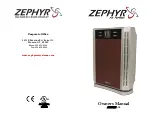
KJM MANDÍK
–
Detailed operating instructions
M&C KJMPNO 07/2022
MANDÍK, a.s.,
63
Position
(
No
/AI/DI
)
– monitoring of the actual position of the dampers:
AI
– actual position is monitored based on the 0-10V analog return signal from the
actuator.
DI
– damper opening is monitored based on the actuator end contact.
SupplyFilter
,
ExhaustFilter
,
GreaseFilter
(
No
/
DI/AI/2xDI/2xAI
)
– manostat with a digital
output implemented by a contact or a pressure sensor with a 0-10V analog output can be
used to monitor filter clogging as follows:
DI
– pressure sensor with an output contact called a manostat is used to monitor the
condition of one filter, and the signalled level of clogging is set
in
ComponentsMachine
Filters
.
2xDI
– two manostats are used to monitor two clogging levels of one filter or one
clogging level of two filters, with the signalled clogging level of every filter set
in
ComponentsMachine
Filters
.
AI
– pressure sensor with an analog output, called a manometer, is used to monitor
the condition of one filter, with the signalled clogging levels set in
ComponentsMachine
Filters
.
2xAI
– for monitoring the status of two filters, pressure sensors with analog output,
called manometers, are used and the signalled clogging levels are set in
ComponentsMachine
Filters
.
SupplyFan
,
ExhaustFan
(
No
/
FM
/EC/
FC–MB
/EC–MB
)
– fan motor can be controlled by a
frequency converter
(FM)
or an EC motor
(EC)
can be used with the following options:
FM
– fan frequency converter is controlled via inputs and outputs.
EC
– EC fan motor is controlled via inputs and outputs.
FC–MB
– fan frequency converter is controlled via Modbus communication.
EC–MB
– EC fan motor is controlled by Modbus communication.
TypeControl
(
Regime
/
Press
/
Direct
/POLv1/POLv2/AMR
)
– the control signal source for the
fans can be:
Regime
– fixed speed value in % for the current regime entered on the controller
display in
ComponentsMachine
Fans
is used to control the speed of the fans.
















































